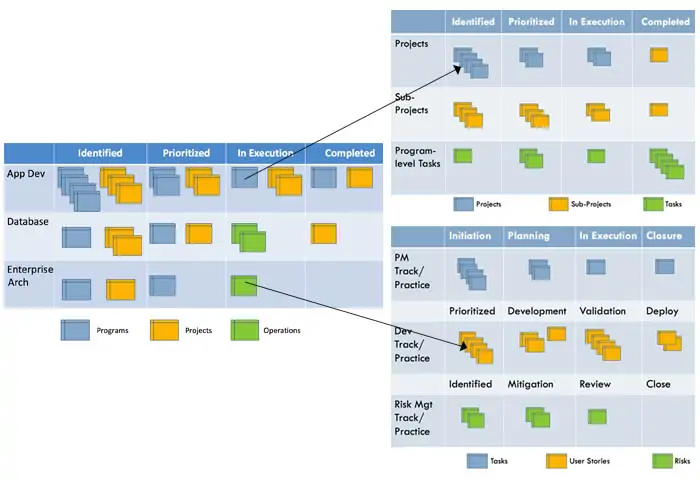Solving the Insulation Challenge of Managed Transformation
With the digital disruption of business models and whole industries, business executives and process owners are faced with a variety of transformation challenges. The need and pressure to deliver and demonstrate improved performance metrics, transparency and collaboration are ever greater.

In this environment, the importance of management frameworks which can be extended and integrated across business processes and projects cannot be overstated. The Kanban method offers a good option, but frequently gets limited to specific project teams or departmental services. Often for good reason.
A typical environment has various teams working with their different tools and solutions, failing to provide a global perspective of their place in the overall system. In such cases, driving organization-wide transformation can be achieved only through the meaningful integration of these disparate systems, allowing stakeholders at higher portfolio levels to get improved visibility of the “big picture”.
In this series of blogposts, we examine:
- The need for an integrated management framework as an essential for mile-stoning and managing transformation.
- What the merits of a Kanban visual integration layer and the necessary capabilities to deliver on this integration are.
- Why this critical visual data integration can fail; tooling and features that need to be built in for success.
- Transformation approach using the enterprise services view, balancing system demand with capability, planning and prioritization using a visual decision framework, using decision support analytics like probabilistic forecasting and cost of delay.
The Big Bottleneck
In most real-world scenarios that we engage with, the bottlenecks can be distilled down to two areas, neither of which are caused by oversight but are largely a consequence of natural progression.
Every function, process or project uses its own tools, for recording, tracking, reporting and/or managing their work. Some of these are point solutions, while others could span functions and processes. A natural outcome is that data relating to the work (actions, projects, processes) which are interdependent, that impact enterprise capacity and performance, now lives in several insulated silos.
It becomes difficult, if not impossible, to gain a meaningful higher-level view of status, health, and risks. While individual parts seem optimized, the system they constitute is not. Not an entirely alien circumstance, you would say.
In most cases, this is a logical outcome of team or project-level investments in processes and tools – and so is almost unavoidable in many respects. It gets more challenging with inorganic growth, when growth through mergers and acquisitions, brings additional integration challenges.
A direct corollary of this phenomenon is that the strategic decision framework gets limited by the siloed views of management data that disparate tools produce.
Managers are forced to manage what they can measure, even if these are not the things that matter to the enterprise, to transform and to compete. This leads to a sub-optimal enterprise, challenged to deliver at the speed and capacity required to compete effectively.
Portfolio Kanban
Kanban delivers on visibility and transparency, providing easy to interpret early cues and signals, helping managers optimize workflow, reduce cycle times and “time to value”.
The term “Portfolio Kanban” is often used to describe the process of managing portfolios of projects and business services using a hierarchy of Kanban boards, to track services at different levels with ease. The hierarchical Kanban boards, each with their appropriate stakeholders, help to visually track status, with easy cues and early signals, providing the relevant level of detail in near real time.
The strength of Kanban is that its basic principles can be applied at any level of an organization’s workflow – strategic initiatives, portfolios, programs, projects, and processes. Kanban encourages a Systems Thinking approach, helping pursue global system-wide optimization, as opposed to a few local optimizations. Consider the view that an enterprise is a set of services, which integrates with other services within or outside its function, with a shared common goal to deliver products/services to customers, in an optimized and profitable manner.
When inter-related, co-dependent critical services are aggregated at higher levels – as a Portfolio Kanban or an Enterprise Kanban – with meaningful data integration of their work tracking/ monitoring tools, you have a potent enterprise management framework for driving true transformation.
Way Forward
The need for an integrated management framework, which supports transformation taking a system-wide view, is undisputed. Portfolio Kanban is a potential solution, which can mitigate the big bottleneck, helping transform the enterprise to a globally-optimized services delivery mechanism.
Working closely with thought-leaders and with some of the largest enterprises in the world, we have invested in this paradigm.
In the next few blogposts of this series, we examine this further – what are the benefits and merits of using Portfolio Kanban as the resolution, and what it really takes to build a fit-for-purpose product or service, without re-inventing or replacing existing tools.
Navin Anand
Regional Director – UK & Europe
This is the first blog post in a four-part series, you can find the other posts from the links below:
Part 2. Visual Management of Enterprise Services
part 3. Enterprise Transformation with Integrated Portfolio Kanban
Part 4. Extending Portfolio Kanban with Enterprise Services Planning









